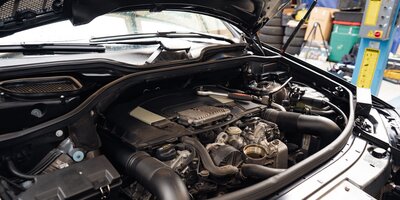BIZOL DPF REGENERATION+ D61
Diesel particulate filter, what is it and what can go wrong?
The emergence of the diesel particulate filter is a consequence of the need for vehicles to comply with ever-more stringent emissions standards. Nowadays, all diesel-engined vehicles are equipped with a diesel particulate filter (DPF) from the factory. Its primary function is to remove fine soot particulates from the exhaust gas. The DPF is like any other filter, it needs to be cleaned or replaced at regular intervals. The engine management system normally takes care of regenerating the DPF on a regular basis, but only when operating conditions allow.
How does DPF regeneration work?
In order to ensure that the DPF keeps working properly, it needs to be able to regenerate i.e., purge the soot trapped in the filter. During filter regeneration, the soot particles, filtered out of the exhaust gases during normal operation, are burnt off and the fine pores of the filter are free again.
In order to start regeneration, the exhaust gas must reach a temperature of at least 600°C and the need to reach this temperature is where the difficulty starts. The exhaust gas usually only reaches this temperature on long motorway journeys at high speed. Frequent driving in stop-start traffic rarely allows the exhaust gas temperature to rise above 400°C. Regeneration is not performed and the soot is not burnt off, which increasingly affects the function of the DPF by clogging it.
What are the symptoms of a blocked diesel particulate filter?

If the number of DPF regeneration cycles are reduced or not carried out at all – due to the regeneration conditions not being met – the result is a blocked filter. After a number of operating hours without regeneration being performed, the engine management will switch on a warning light on the dashboard.
If automatic regeneration is still not carried out due to the conditions not being met, you will have to get the DPF cleaned or may even have to get the clogged filter replaced. BIZOL DPF regeneration+ d61 cleans the DPF even if the vehicle only covers short distances and is driven in city traffic.
Unfavourable driving profiles hinder effective automatic DPF regeneration
Real-world operating conditions may hamper or prevent automatic regeneration of the DPF. In addition, the accumulation of deposits that clog injectors, cause a build-up of dirty on the exhaust gas recirculation valve, such as the incorrect engine oil type or poor fuel quality can result in premature clogging of the filter.
Signs that it is time to clean the diesel particulate filter
The warning signs that indicate the DPF could be clogged include reduced performance, increased fuel consumption and exhaust emissions, etc. and, of course, the DPF warning light illuminating on the dashboard. If you notice any of these phenomena it’s high time to use a special fuel additive such as BIZOL DPF Regeneration+ d61.

How does diesel particulate filter cleaning work?
BIZOL DPF Regeneration+ d61 lowers the temperature for burning the particulates to 350°C. At 350°C regeneration of the DPF is possible even when driving frequently in stop-start traffic i.e., city traffic. It couldn’t be simpler, just pour the product directly into the fuel tank. In countries with good fuel quality, we recommend its use at every third tank filling. In countries with poor fuel quality, our experts advise a preventive application every time you fill the tank.
Still unsure? Here is a list with the top four advantages of a clean diesel particulate filter:
- improved performance
- reduced fuel consumption
- reduced exhaust emissions
- maximum top speed
Regeneration by long distance driving
Particulate filter regeneration needs to be given priority as a maintenance task in order to avoid unnecessary workshop costs. It is essential that DPF regeneration is carried out regularly to prevent increased fuel consumption and power loss due to a blocked DPF.
Certain driving profiles can promote automatic purging of the DPF. Maintaining a constant speed over long distances allows the exhaust gas to reach the required combustion temperature. Driving profiles like this are synonymous with long motorway or longer cross-country journeys which facilitate regeneration of the DPF.
Regeneration by driving as usual
It is easier, faster and cheaper to simply buy BIZOL DPF Regeneration+ d61 and pour it into the fuel tank, rather than having to plan an additional motorway trip. Application could not be simpler, just add it every time you refuel or every third tankful. It has a catalytic effect and lowers the soot ignition temperature to approx. 350 °C to ensure continuous soot burn-off even at low loads and lower temperatures.

You might also like

The modern marvel of an internal combustion motor powers our vehicles, providing the strength and reliability we rely on for daily transportation. However, just like anything else subjected to constant use, motorized units experience wear and tear over time. Component deterioration can significantly impact performance and longevity. In this article, we will delve into the intricacies of engine wear meaning, explore the various causes behind it, provide actionable tips to reduce and prevent it. Furthermore, we will look at how specialized engine oils, such as BIZOL, play a crucial role in safeguarding your engine’s health. Let’s begin by understanding what engine wear is and the factors that contribute to it.

The melodious purr of a motor, the velvety transition of cog-wheel, and the elegant voyage along the expansive highway — these are the unmistakable characteristics of a meticulously calibrated self-shifting gearbox system. But what transpires when the motorized ensemble falters, the cogs gnash, and the voyage veers into an unforeseen tempest? Get into the realm of automatic transmission problems, a domain where automotive aficionados and everyday motorists alike encounter the enigmatic intricacies of this complex system.

Driving is a blend of exhilaration and convenience, but sometimes, your trusty car can hit a snag. One of the most frustrating issues is a coolant leak.
Coolant, often referred to as the versatile 'antifreeze,' assumes the uncelebrated role of an automotive guardian, ensuring your engine's harmonious operation. This unassuming fluid stands as a bulwark against the scorching summer heat and the bone-chilling cold of winter. Nevertheless, when the vigilance of antifreeze wanes, and it embarks on an unauthorized journey beyond its confines, ominous troubles come into view.

